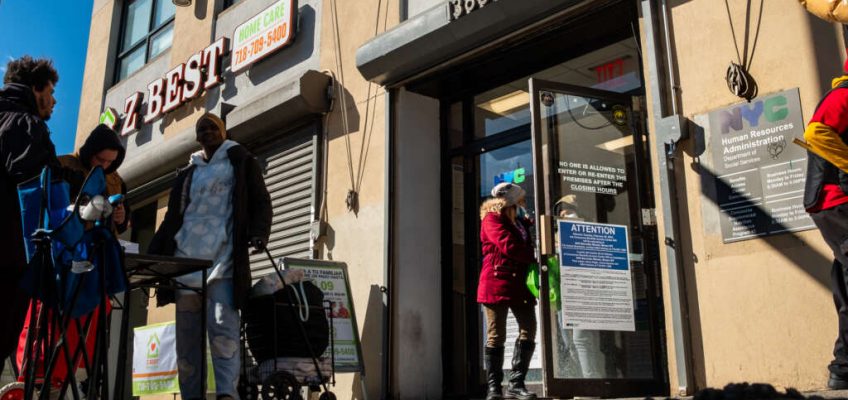“Lawmakers must invest in redesigning our public assistance infrastructure, not only in a physical sense but also in a philosophical one. This system reflects what we, as a city, choose to value, and it’s time for that to change.”
The exterior of HRA’s walk-in benefits center, formerly located on Jerome Avenue in The Bronx. (Photo by Adi Talwar)
Earlier this year, a former colleague of mine found themselves in a dire situation. A sudden drop in income left them unable to pay rent, so they applied for a one-time rent assistance deal through the Human Resource Administration (HRA) office. Despite uploading every required document multiple times, both through the app and by showing me the confirmation screenshots, their application was repeatedly denied. Now, they’re on the verge of eviction, not because they failed the system, but because the system failed them. It’s a cruel irony: a process meant to provide emergency relief often functions like a silent blockade.
HRA offices, designed to be lifelines for New Yorkers in financial distress, often resemble obstacle courses. Long waits, confusing check-ins, missing documents, and penalties for minor errors transform a simple request into a psychological and logistical gauntlet. The physical and procedural architecture of these offices sends a clear message: you’re not welcome here.
This is what architectural historian David Gissen describes as a “disabling form” – a design that prioritizes aesthetics, coherence, and systemic control over the human experience. Although Gissen speaks of “inaccessibility” in physical spaces, his ideas also apply to bureaucratic ones. HRA’s ideal client seems to be endlessly patient, tech-savvy, highly literate, and fluent in “bureaucratese.” Everyone else, a.k.a. real people with urgent needs, are alienated and pushed out.
Interestingly, technology hasn’t improved the experience either. While the “Access HRA” portal is designed to streamline the application process, it often complicates it by replicating the same barriers in digital form. Virginia Eubanks argues in “Automating Inequality” that online systems tend to “bake in” biases by turning what should be a support mechanism into a silent denial. Let us not forget that people without access to Wi-Fi or basic technological literacy are often left behind. Moreover, proving one’s need can be overwhelming.
Some may argue that rigid policies and processes are necessary to prevent fraud. But what’s the cost of punishing the honest to catch the dishonest? Most importantly, what happens when the people behind the desk are struggling too?
Michael Lipsky’s “Street-Level Bureaucracy” highlights the plight of caseworkers. These workers must enforce complex policies while balancing empathy and care, a task made even more challenging by the lack of necessary resources. They are compelled to rush through interviews in under 30 minutes just to meet quotas, a result of being outnumbered and under-resourced. From my personal experience as a former client interacting with caseworkers, I realized that they often lack the necessary time and proper training to fully understand a client’s complex needs.
Eventually, that compassion calcifies into frustration. Lipsky notes that burned-out caseworkers often default to gatekeeping as a form of survival. I don’t excuse poor conduct that disenfranchises marginalized groups, but I understand it. Many chose this profession to make a difference, yet they’re cast as villains, required to enforce draconian rules with little to no discretion. Everyone loses when both staff and clients are demoralized.
Optimistically, it doesn’t have to be this way. Imagine walking into an HRA office that feels like a community center, with clear signage and seating that invites comfort, not surveillance. Picture caseworkers who are well-resourced and have the discretion and time to listen. Envision integrating tools like appointment reminders, video interview options, and document trackers into the procedural design; we could eliminate confusion and address anticipated gaps to prevent illegitimate application denials. This is the kind of environment that our public assistance offices should strive to create, one that is welcoming and comfortable for those in need.
According to a May 2025 press release from City Hall, New York City is finalizing its fiscal year 2026 executive budget. Mayor Eric Adams has dubbed it the “Best Budget Ever,” a balanced budget of $115.1 billion that includes investments in public safety, education, and housing. This is the time to urgently address the structural flaws in our social safety net. Immediate reform is crucial in systems like the HRA, which are designed to uphold our values of affordability and support for low-income New Yorkers.
We cannot afford another year of policies that disenfranchise the marginalized and exhaust those tasked with assisting them. Lawmakers must invest in redesigning our public assistance infrastructure, not only in a physical sense but also in a philosophical one. This system reflects what we, as a city, choose to value, and it’s time for that to change.
While New Yorkers take pride in their toughness and resilience, we also recognize that compassion and efficiency are not signs of weakness but rather the cornerstones of a functioning system. Our public assistance offices must fulfill their purpose by treating those in need with dignity and improving working conditions, enabling their staff to serve clients more effectively. When politicians tout “cutting red tape” and safety nets, remember my former colleague who is now on the verge of eviction. A system that disables its participants—clients and workers alike—demands urgent transformation.
We need to hold our city accountable for genuinely ensuring access for marginalized communities. In the most resourceful city in the world, no one should have to hit the bullseye just to get help.
Joy Wefum is a student at Columbia University’s School of General Studies, majoring in Urban Studies with a concentration in Public Health. With a professional background as a patient care coordinator and board member (executive committee) of Legal Services NYC, he is passionate about the intersection of urban design, public systems, health equity, and social justice.
The post Opinion: Making NYC’s Public Benefits System Truly Accessible appeared first on City Limits.


Leave a Reply